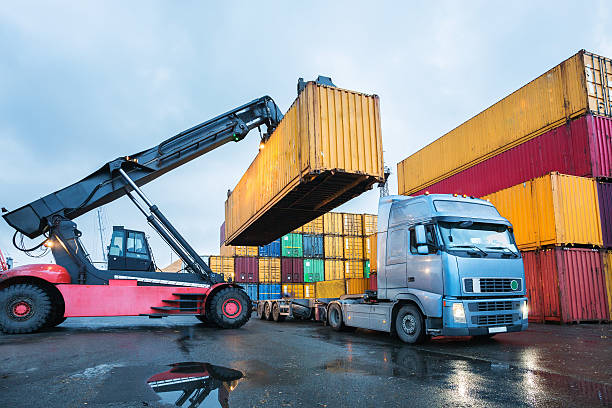Transporting shipping containers efficiently and securely is crucial to ensuring the safety of cargo and the integrity of the containers. Whether you are a logistics professional or an individual moving goods, these seven tips will help you secure shipping containers effectively during transport. In addition to being crucial for your cargo’s safety, putting these useful shipping containers security guidelines into practice will increase the process’s overall efficiency.
1. Proper Container Inspection
Proper container inspection is a critical step in ensuring the safe and secure transportation of goods. Before loading cargo, meticulously examine containers for any damages, such as dents, cracks, or rust. Assess the structural integrity of the container, including the flooring and walls. Pay close attention to the condition of the doors, seals, and locking mechanisms to prevent any issues during transit.
Addressing these potential issues beforehand not only safeguards the cargo against damage but also ensures the overall stability of the container, reducing the risk of accidents or structural failures during transportation. Regular inspections contribute to a more efficient and secure logistics process, providing peace of mind to shippers and logistics professionals alike.
2. Quality Locking Mechanisms
Quality locking mechanisms are paramount for ensuring the security of shipping containers during transportation. Opting for high-quality locks that are tamper-resistant is crucial to prevent unauthorized access and theft.
Robust materials and sophisticated locking mechanisms in heavy-duty padlocks provide an additional degree of security. Electronic locks, offering features like remote monitoring and access control, provide a modern and efficient solution for container security. The choice of locking mechanisms should align with the nature of the cargo and the specific security requirements of the shipping operation.
Investing in top-notch locks not only safeguards valuable goods but also contributes to the overall integrity of the supply chain, instilling confidence in shippers and stakeholders involved in the logistics process.
3. Use of Twist Locks
The strategic use of twist locks plays a crucial role in enhancing the safety and stability of shipping containers during transit. Inventive twist locks are used to safely join containers that are piled on top of one another. By mechanically connecting the corner castings of nearby containers, these locks function as a connection. By effectively fastening containers together, twist locks prevent any unwanted movement, reducing the risk of shifting or toppling during the journey.
This not only ensures the safety of the cargo but also contributes to the overall structural integrity of containerized shipments. Implementing twist locks as part of container securing measures is a standard practice in the shipping industry, providing a reliable and standardized solution for container stacking and transportation.
4. Blocking and Bracing Inside the Container
Implementing blocking and bracing techniques within shipping containers is a critical aspect of cargo safety during transportation. This method involves strategically placing materials such as wooden blocks, braces, or inflatable dunnage bags to prevent the cargo from shifting or moving inside the container.
The goal is to create a stable and secure environment, minimizing the risk of damage due to vibrations, sudden stops, or changes in direction during transit. Properly executed blocking and bracing not only protect the integrity of the shipped goods but also contribute to the overall safety and stability of the containerized load.
It’s a tailored approach, with the choice of materials and placement depending on the specific nature of the cargo, ensuring that each item is firmly secured and well-protected throughout the entire journey.
5. Sealing Openings
Sealing openings and vents in shipping containers is a crucial measure to safeguard cargo from the elements during transportation. Weather conditions, such as rain or sea spray, can pose a significant risk to the integrity of goods inside the container.
By meticulously sealing any unnecessary openings, including vents and gaps, you create a protective barrier against moisture, preventing water ingress. Utilizing weather-resistant seals or tapes designed for maritime and shipping applications ensures a tight seal that can withstand the challenges of the journey.
This meticulous sealing process not only shields the cargo from potential water damage but also contributes to maintaining the overall quality and condition of the shipped goods. It’s a proactive step in enhancing the container’s weather resistance and securing the cargo against external environmental factors.
6. Proper Weight Distribution:
Proper weight distribution plays a pivotal role in the safe transport of goods within shipping containers. Efficiently loading and distributing weight inside the container and on the transporting vehicle contribute to overall stability, reducing the risk of tipping during transportation.
Balancing the weight evenly helps maintain the structural integrity of both the container and the transport vehicle, ensuring a smoother and safer journey for the cargo. Logistics professionals must be mindful of shipping container capacity guidelines and adhere to best practices in weight distribution to optimize the safety and efficiency of the shipping process.
7. Adherence to Regulations
Adherence to international and local regulations is paramount in container transport, as it ensures not only the safety of the cargo but also minimizes the risk of legal complications. International shipping involves a complex web of regulations covering aspects such as container specifications, weight limits, labeling requirements, and documentation.
Ensuring that containers meet the specified standards and are appropriately labeled contributes to the overall safety and efficiency of transportation. Moreover, compliance with regulations helps prevent delays at ports and border crossings, facilitating a seamless flow of goods. Keeping abreast of these regulations and implementing the necessary measures demonstrates a commitment to responsible and lawful container transport practices, benefiting both the shipper and the broader logistics industry.
Conclusion
It is crucial to secure shipping containers in order to ensure the efficient and safe transit of commodities. You’ll help make the transportation process safer and more efficient by heeding our advice. Appropriate container security is necessary for cargo transportation in order to ensure both the cargo’s safety and the overall efficiency of the shipping process. Incorporating these tips into your cargo handling practices will help maintain the integrity of shipments during transit.

